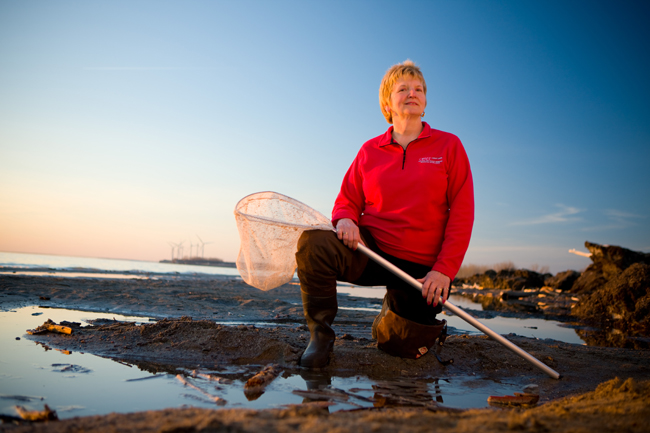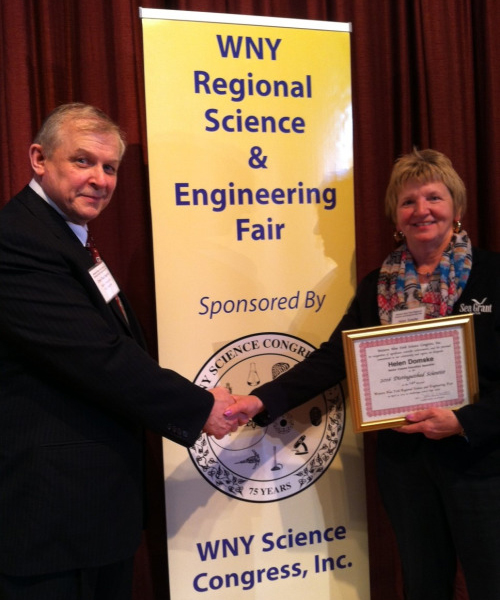
New York Sea Grant's Helen Domske, based in Buffalo, has perfected teach-the-teacher educational workshops that provide K-12 teachers with hands-on learning and science-based Great Lakes curriculum development opportunities along the shoreline of NY and aboard federal research vessels that regularly monitor the Lake Ontario and Lake Erie ecosystem.
Buffalo, NY, May 16, 2016 - New York Sea Grant Coastal Education Specialist Helen Domske has received the 2016 Distinguished Scientist award from the Western New York (WNY) Science Congress. She was bestowed the honor at WNY Regional Science and Engineering Fair’s 2016 Awards Ceremony in early May.
"We are proud of Helen and all of our staff who support teachers, businesses, local governments, state and federal agencies as well as those who live, work and play along our numerous coast lines,“ says NYSG Associate Director Kathy Bunting-Howarth. "Her educational expertise benefits not only teachers and students, but has positively impacted businesses; local, state and federal government representatives; and all those who live, work, and play along New York coastlines.”
"New York Sea Grant’s motto is ‘bringing science to the shore’ and I am proud and delighted that I have been bestowed this award for being able to bring Great Lakes and marine science to students, teachers and stakeholders from coastal areas around the state,” says Domske. For an example of this, see a summary of Domske's recent educational efforts, "NYSG Advancing Great Lakes Education: From Algae to Zooplankton" (pdf).
Each year, the WNY Science Congress’ Board of Directors identify a renowned scientist from one of Western New York’s eight counties whose accomplishments are of importance not only to the region, but possibly recognized nationally or globally. Previous winners include the inventor of the pacemaker and a Nobel Prize winning scientist, along with others, so she was honored by the selection.
"Being recognized by other scientists is extremely rewarding and following in the footsteps of acclaimed scientists is a true honor,“ says Domske. "My work with Sea Grant has provided me with outstanding experiences, including time aboard research vessels and working along the shores of Lake Erie and Lake Ontario, which has added to my scientific background and kept me enthusiastic about sharing knowledge with others to protect freshwater and marine habitats.”
In addition to these train-the-trainer activities, Domske is an active member in the award-winning Great Lakes Sea Grant Network’s campaigns to keep pharmaceuticals and microplastics out of New York’s waters.
“We want people to stop flushing pharmaceuticals down the toilet or the drain,” says Domske, who has written a fact sheet (pdf) on the subject. “We tell people not to flush them down the drain because it does eventually get out to into the water system."
As for microplastics, she explains in another fact sheet (pdf) that although the issue might bit more involved, the message is still clear: Be mindful of the personal care products you use and dispose of plastic bottles in the proper receptacles. "For years people have worried about the environmental impacts from plastics left behind in the oceans and Great Lakes,” says Domske. “More recently, though, attention has turned to small plastic particles and microbeads that have been found in our waters.”
Domske, who is also the Associate Director of the Great Lakes Program, is located at the University at Buffalo, which is one of four offices the program maintains in New York’s Great Lakes region. Others include Cornell University, Newark's Wayne County Cooperative Extension office and SUNY Oswego. In the State’s marine waters, NYSG has offices at Stony Brook University and Stony Brook Manhattan, in the Hudson Valley through Cooperative Extension in Kingston and at Brooklyn College.

NYSG's Helen Domske (pictured at right, receiving an award from WNY Regional Science and Engineering Fair's Executive Director John Paul Martin) is an active leader in the award-winning Great Lakes Sea Grant Network campaigns to keep pharmaceuticals and microplastics out of New York state waters. She annually coordinates a State of Lake Erie meeting that features fisheries experts with local, state and federal agencies and is attended by diverse stakeholders from the Western NY region.

New York Sea Grant was a co-sponsor of this year's Great Lakes Student Summit, held on May 9th at the Buffalo Museum of Science. NYSG's Helen Domske coordinated all of our program's involvement in the event, which, since 1995, has been an annual environmental education program for students from throughout the Great Lakes States and Canada. This year, over 150 students from area districts and homeschoolers learned about the many watersheds that make up these key U.S. (and global) freshwater resources. Photo: Lower Great Lakes Fish & Wildlife Conservation Office
More Info: New York Sea Grant
New York Sea Grant (NYSG), a cooperative program of Cornell University
and the State University of New York, is one of 33 university-based
programs under the National Sea Grant College Program (NSGCP) of the
National Oceanic and Atmospheric Administration (NOAA). The NSGCP
engages this network of the nation’s top universities in conducting
scientific research, education, training and extension projects designed
to foster science-based decisions about the use and conservation of our
aquatic resources. Through its statewide network of integrated
services, NYSG has been promoting coastal vitality, environmental
sustainability, and citizen awareness about the State’s marine and Great
Lakes resources since 1971.
New York Sea Grant maintains Great Lakes offices at SUNY Buffalo, the
Wayne County Cooperative Extension office in Newark and at SUNY Oswego.
In the State's marine waters, NYSG has offices at Stony Brook University
and Stony Brook Manhattan, in the Hudson Valley through Cooperative
Extension in Kingston and at Brooklyn College.
For updates on Sea Grant activities: www.nyseagrant.org has RSS, Facebook, Twitter, and YouTube links. NYSG also offers a free e-list sign up via www.nyseagrant.org/coastlines for its flagship publication, NY Coastlines/Currents, which is published several times a year.